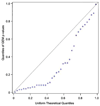Vitamin D receptor polymorphisms in patients with cutaneous melanoma
- PMID: 21365644
- PMCID: PMC3135781
- DOI: 10.1002/ijc.26023
Vitamin D receptor polymorphisms in patients with cutaneous melanoma
Abstract
The vitamin D receptor (VDR) gene has been associated with cancer risk, but only a few polymorphisms have been studied in relation to melanoma risk and the results have been inconsistent. We examined 38 VDR gene single nucleotide polymorphisms (SNPs) in a large international multicenter population-based case-control study of melanoma. Buccal DNAs were obtained from 1,207 people with incident multiple primary melanoma and 2,469 with incident single primary melanoma. SNPs with known or suspected impact on VDR activity, haplotype tagging SNPs with ≥ 10% minor allele frequency in Caucasians, and SNPs reported as significant in other association studies were examined. Logistic regression was used to calculate the relative risks conferred by the individual SNP. Eight of 38 SNPs in the promoter, coding, and 3' gene regions were individually significantly associated with multiple primary melanoma after adjusting for covariates. The estimated increase in risk for individuals who were homozygous for the minor allele ranged from 25 to 33% for six polymorphisms: rs10875712 (odds ratios [OR] 1.28; 95% confidence interval (CI), 1.01-1.62), rs4760674 (OR 1.33; 95% CI, 1.06-1.67), rs7139166 (OR 1.26; 95%CI, 1.02-1.56), rs4516035 (OR 1.25; 95%CI, 1.01-1.55), rs11168287 (OR 1.27; 95%CI, 1.03-1.57) and rs1544410 (OR 1.30; 95%CI, 1.04-1.63); for two polymorphisms, homozygous carriers had a decreased risk: rs7305032 (OR 0.81; 95%CI 0.65-1.02) and rs7965281 (OR, 0.78; 95%CI, 0.62-0.99). We recognize the potential false positive findings because of multiple comparisons; however, the eight significant SNPs in our study outnumbered the two significant tests expected to occur by chance. The VDR may play a role in melanomagenesis.
Copyright © 2011 UICC.
Figures



References
-
- Colston K, Colston MJ, Feldman D. 1,25-dihydroxyvitamin D3 and malignant melanoma: the presence of receptors and inhibition of cell growth in culture. Endocrinology. 1981;108:1083–1086. - PubMed
-
- Danielsson C, Fehsel K, Polly P, Carlberg C. Differential apoptotic response of human melanoma cells to 1 alpha,25-dihydroxyvitamin D3 and its analogues. Cell Death Differ. 1998;5:946–952. - PubMed
-
- Evans SR, Houghton AM, Schumaker L, Brenner RV, Buras RR, Davoodi F, Nauta RJ, Shabahang M. Vitamin D receptor and growth inhibition by 1,25-dihydroxyvitamin D3 in human malignant melanoma cell lines. J Surg Res. 1996;61:127–133. - PubMed
-
- Ranson M, Posen S, Mason RS. Human melanocytes as a target tissue for hormones: in vitro studies with 1 alpha-25, dihydroxyvitamin D3, alpha-melanocyte stimulating hormone, and beta-estradiol. J Invest Dermatol. 1988;91:593–598. - PubMed
-
- Yudoh K, Matsuno H, Kimura T. 1alpha,25-dihydroxyvitamin D3 inhibits in vitro invasiveness through the extracellular matrix and in vivo pulmonary metastasis of B16 mouse melanoma. J Lab Clin Med. 1999;133:120–128. - PubMed

